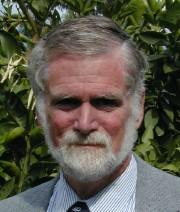2005 Haagen-Smit Prize Winners
The Executive Editors and the Publisher of Atmospheric Environment take great pleasure in announcing the fifth ''Haagen-Smit Prize'', designed to recognize outstanding papers published in Atmospheric Environment. The Prize is named in honor of Prof. Arie Jan Haagen-Smit, a pioneer in the field of air pollution and one of the first editors of the International Journal of Air Pollution, a predecessor to Atmospheric Environment.
The ''Haagen-Smit Prize'' is given annually to two papers previously published in Atmospheric Environment and covering different science areas. Additional information about this award and the selection committee members can be found at https://earthscience.arc.nasa.gov/singh/. The two 2005 winning papers are described below.
Nomination Letters
 Pankow, J. F., An absorption model of the gas/aerosol partitioning involved in the formation of secondary organic aerosol, Atmospheric Environment, 28, 189-193, 1994.
Pankow, J. F., An absorption model of the gas/aerosol partitioning involved in the formation of secondary organic aerosol, Atmospheric Environment, 28, 189-193, 1994.
I would like to nominate Dr. James F. Pankow of the Oregon Health & Sciences University for the 2005 Haagen-Smit Prize for the above contribution published in Atmospheric Environment in 1994. This paper represents a groundbreaking advance in the understanding of secondary aerosol formation, and indeed in the understanding of the partitioning of all organic compounds to atmospheric particulate matter (PM) whether of primary emission or secondary reaction origin.
Prior to the publication of Pankow (1994), the theoretical treatment of secondary organic aerosol yields typically involved a simple condensation model based on the equilibrium partitioning of pure substances involving only pure compound liquid vapor pressures. Those treatments ignored the powerful and overriding effects of dissolution on the partitioning process. The introduction of the correct theory governing absorptive partitioning to impure multicomponent phases by Pankow (1994) has been critically important in explaining the importance of atmospheric aerosol formation by reaction of biogenic and anthropogenic hydrocarbons and aromatic hydrocarbons. It has represented an enormous step forward in our understanding of the aerosol attachment process, has better explained experimental data, and has provided the ability to include the correct physical process in all of the computational models in use around the world for predicting organic contributions to atmospheric aerosols.
The importance of the Pankow (1994) paper was quickly recognized by the field. It was rapidly and widely assimilated into models of secondary organic aerosol formation (both in chambers and in the atmosphere), and strongly influenced the direction of some well established research groups in the field, including those of John Seinfeld, Richard Kamens, and the EPA Atmospheric Modeling Division, among many others. The work has had a global impact on atmospheric chemistry research, and has been cited by numerous authors throughout North America, Europe, and Asia. This paper has been cited 140 times and on more than one occasion I have heard this paper discussed by numerous speakers at national meetings. I believe that its influence on our understanding of urban air pollution, global climate, and atmospheric chemistry can only continue to grow.
Organic atmospheric PM unquestionably plays numerous fundamentally important roles in the atmosphere. While uncertainties still exist with regard to organic PM source budgets, composition, reactions, and behavior, the Pankow (1994) paper represents a powerful framework for obtaining the answers to these important questions in atmospheric science.
Nominator: Stephen R. McDow, Environmental Protection Agency, USA
Prof. James F. Pankow, Oregon Health & Science University, Beaverton, Oregon, USA (pankow@ese.ogi.edu)
 Carter, W. P. L., A Detailed Mechanism for the Gas-Phase Atmospheric Reactions of Organic Compounds, Atmospheric Environment, 24A, 481-518, 1990.
Carter, W. P. L., A Detailed Mechanism for the Gas-Phase Atmospheric Reactions of Organic Compounds, Atmospheric Environment, 24A, 481-518, 1990.
I am nominating the above publication in Atmospheric Environment for the 2005 Haagen-Smit Prize. This highly-cited paper describes the formulation and testing of the first really detailed chemical mechanism for the atmospheric photooxidations of the major classes of volatile organic compounds (VOCs), including alkanes, alkenes, aromatic hydrocarbons, alcohols and ethers and their degradation products. This mechanism was developed by Bill Carter during the mid/late 1980's and it represented a major advance over previously available chemical mechanisms. All previous chemical mechanisms for the atmospheric photooxidations of VOCs either used a "lumped" chemical approach in which a few selected species were used to represent all members of a VOC class (for example, n-butane and n-octane to represent all alkanes) or the "Carbon-Bond" approach in which a chemical was broken down into alkane groups, alkene double bonds, aromatic rings, etc. (with, for example, toluene being represented as an aromatic ring plus an alkane CH3 group).
The approach used by Bill Carter was to formulate reaction schemes for the various VOC classes using the then available literature database, with reaction rate constants and product yields which were specific to each member of a particular VOC class. While the complex series of products formed were treated in a less detailed manner (the aldehydes in the mechanism being formaldehyde, acetaldehyde and propanal, with propanal serving as the generic ≤C3 aldehyde, and similarly for the ketones and other oxygenated products), this was a vast improvement over previous mechanisms in terms of the level of detail included. Furthermore, the reactions of organic peroxy radicals with HO2 and organic peroxy radicals were included, and hence the mechanism could be realistically used under low-NOxconditions and it was scientifically more credible in terms of its atmospheric applicability than previous mechanisms.
This publication in Atmospheric Environment, together with a companion publication discussing and presenting the extensive testing and evaluation of this mechanism against a large body of environmental chamber data from four laboratories (Carter and Lurmann, Atmospheric Environment,25A, 2771-2806, 1991), set a new standard for the formulation, testing and presentation of detailed chemical mechanisms in the literature. Furthermore, this 1990 mechanism (termed the "SAPRC 1990" mechanism) served as the basis for more condensed mechanisms used in urban and regional airshed models. The importance of this publication is evidenced by the 259 citations it has received to date. Bill Carter progressively updated the mechanism presented in this 1990 Atmospheric Environmentpaper, leading successively to the SAPRC 1991, SAPRC 1997 and SAPRC 1999 mechanisms, with the 1999 mechanism being documented in a several hundred page peer-reviewed report to the California Air Resources Board in 2000.
Bill Carter's publication in Atmospheric Environment, 24A, 481-518 (1990) is thoroughly deserving of the 2005 Atmospheric Environment Haagen-Smit Prize, and I am very pleased to nominate it for this award.
Nominator: Roger Atkinson, University of California, Riverside, USA
Prof. William P. L. Carter, University of California, Riverside, California, USA (carter@cert.ucr.edu)
Our congratulations go to the authors of the two outstanding papers selected for the 2005 Prize. We would also very much like to thank all the other nominators for their effort and note that unsuccessful nominations are eligible for consideration again next year. We further take this opportunity to acknowledge the conscientious effort of the selection committee, made up of members from five countries, in arriving at a clear and timely decision.
Hanwant B. Singh and Peter Brimblecombe,
Executive Editors of Atmospheric Environment.
Hetty Verhagen,
Senior Publishing Editor, Elsevier Science.
